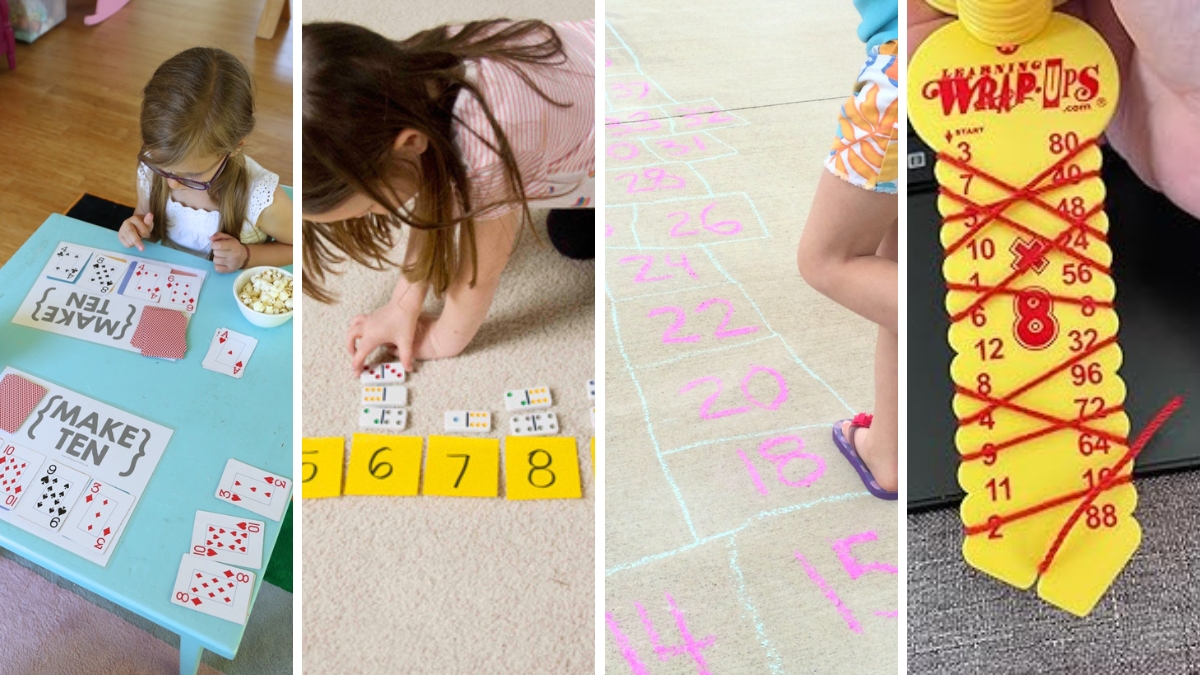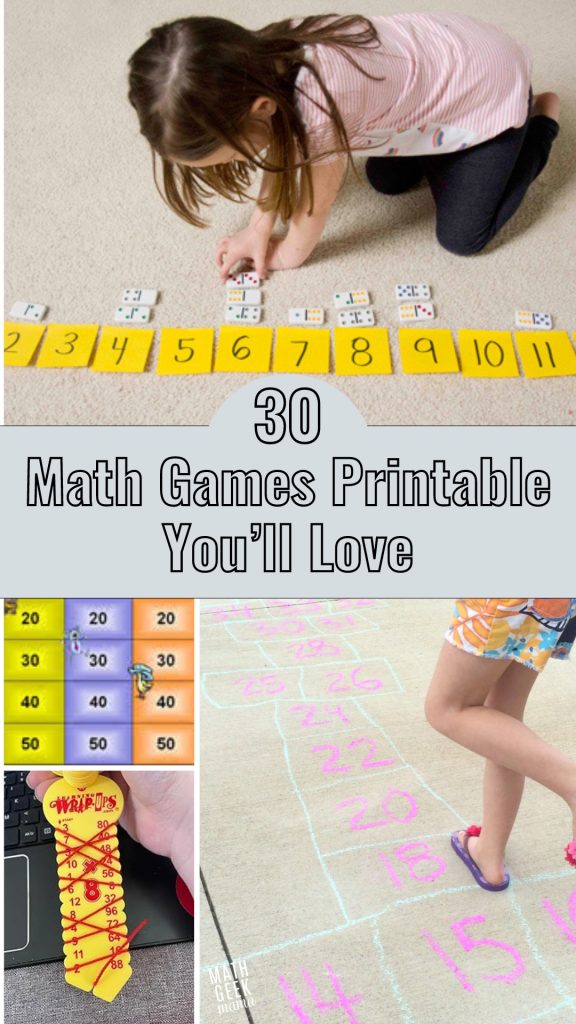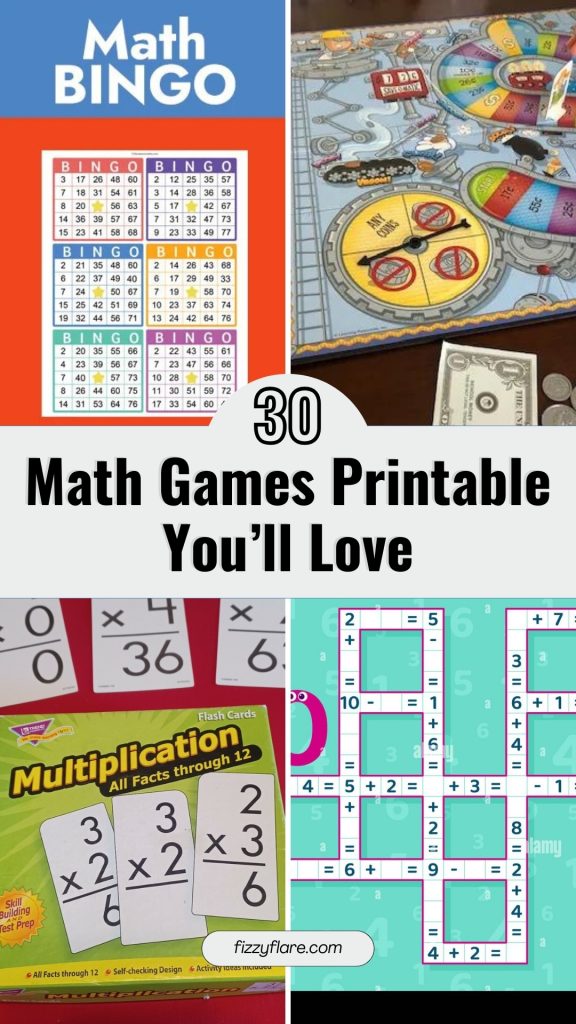30 Math Games Printable for 2025

Printable math games are a great way to make learning enjoyable for kids, offering a variety of interactive and creative ways to practice math skills.
In this article, I’ll share 30 printable math games that are both educational, enjoyable, and perfect for helping children practice their math skills.
Let’s begin!
Contents
- 1 30 Math Games Printable
- 1.1 1. Line Up Math Game
- 1.2 2. String Multiplication
- 1.3 3. Math Charades
- 1.4 4. Jeopardy
- 1.5 5. Math Fortune Tellers
- 1.6 6. Parking Lot Cars Game
- 1.7 7. Popsicle Stick Counting
- 1.8 8. Subtraction Smash
- 1.9 9. Math Hopscotch
- 1.10 10. Nerf Gun Math
- 1.11 11. Jelly Bean Jumbles
- 1.12 12. Domino Addition
- 1.13 13. Make 10
- 1.14 14. Whack It Place Value
- 1.15 15. Math Twister
- 1.16 16. Lego Fraction Game
- 1.17 17. Math Facts Garden
- 1.18 18. Strike It Out
- 1.19 19. Egg Carton Shake Up
- 1.20 20. Count Your Dots
- 1.21 21. Math Bingo
- 1.22 22. Math Puzzles
- 1.23 23. Printable Math Worksheets
- 1.24 24. Christmas Math Games
- 1.25 25. Halloween Math Games
- 1.26 26. Addition Bingo
- 1.27 27. Multiplication Flash Cards
- 1.28 28. Math Crosswords
- 1.29 29. Number Matching
- 1.30 30. Math Board Games
30 Math Games Printable

1. Line Up Math Game
In the Line Up Math Game, students pick numbered slips of paper from a bowl and arrange themselves in ascending order based on the numbers they have.
To make this game, you should write different numbers relevant to the students’ grade level on paper slips and mix them in a bowl.
Each student picks a slip, and the challenge begins. They need to discuss and interact with each other to determine the correct sequence from the smallest to the largest number.
2. String Multiplication
String Multiplication is a hands-on game for practicing multiplication and pattern recognition. You should divide students into groups of ten and have them sit in a circle.
Assign each group a number and give them a ball of yarn. The students pass the yarn across the circle according to the multiples of their assigned number, creating a web.
For example, a group assigned the number 6 will pass the yarn from 0 to 6, then 12, and so on.
This visual and interactive method helps students master multiplication tables and identify numerical patterns.
3. Math Charades
To play this game, you should print and cut out the free Math Charade Cards available online, which contain various math terms and problems.
Players take turns acting out the terms or solving the problems without speaking, while their team guesses.
This game helps students reinforce their math vocabulary and problem-solving skills in a fun, interactive way.
4. Jeopardy
Jeopardy is a team-based game that covers various math topics such as multiplication, fractions, and geometry.
To set up, divide a chalkboard or whiteboard into three sections for different math topics, and write questions of varying difficulty levels under each section.
Assign point values to each question based on its difficulty. Students take turns choosing a question and answering it to earn points for their team.
5. Math Fortune Tellers
Math Fortune Tellers, or “cootie catchers,” are paper games where kids solve math problems to find out their “fortunes.”
To make these, you should fold a piece of paper into a fortune teller shape, and write math problems inside.
Kids take turns picking numbers, colors, or shapes, and solving the math problems revealed. This game helps students practice math in a fun and engaging way.
6. Parking Lot Cars Game
In the Parking Lot Cars Game, students use toy cars and a felt parking lot to solve math problems. You should create a parking lot grid on a piece of felt and write different math problems in each parking space.
Kids use toy cars to “drive” to a space and solve the problem of parking. This hands-on game helps younger students with number recognition and simple math operations. It’s engaging and interactive, making math practice feel like playtime.
7. Popsicle Stick Counting
In Popsicle Stick Counting kids use popsicle sticks to practice counting by different increments, such as 5s or 10s. Write numbers on the sticks and have kids pick a stick, then count up or down from that number using the increments.
This game reinforces counting skills and number sequences. It’s easy to set up and can be tailored to different skill levels by changing the increment.
8. Subtraction Smash
In this game kids roll play dough into small balls and place them on a mat with subtraction problems. They solve the problem by smashing the corresponding number of balls.
For example, if the problem is 5 – 3, they smash three balls out of five. This tactile approach helps kids visualize subtraction and makes learning interactive and fun.
It’s a great way to combine sensory play with math practice, especially for young learners who benefit from hands-on activities.
9. Math Hopscotch
In the Math Hopscotch game kids solve math problems while playing hopscotch. Draw a hopscotch grid with numbers on the ground and assign math problems to each square.
Kids hop through the grid and solve the problems as they land on each square. This game promotes physical activity along with math practice.
It’s ideal for outdoor play and helps kids burn energy while reinforcing math skills. The simple setup with chalk and an outdoor area makes it an easy activity.
10. Nerf Gun Math
In the Nerf Gun game kids use Nerf guns to shoot at targets with the correct math answers. Set up targets with different math problems and provide kids with Nerf guns.
They aim and shoot at the target with the correct answer. This game combines physical activity with math practice, making it highly engaging.
It helps improve accuracy and quick thinking as kids solve problems and aim for the correct answers.

11. Jelly Bean Jumbles
Kids receive orders from a menu and must solve math problems to determine the correct number of jelly beans needed.
For example, an order might require “2 red + 3 blue + 4 green jelly beans,” and kids must solve the additional problems to get the correct total.
You should create a simple menu with different jelly bean orders and corresponding math problems.
Use a variety of colored jelly beans and provide each child with a small bag to collect their correct combinations.
12. Domino Addition
In the Domino Addition players draw dominoes and add the numbers on each half. The player with the highest total wins that round. For example, a domino with 3 and 5 would be an 8.
You need a set of dominoes, a score sheet, and a pen. Each player draws a domino and adds the numbers, recording their score. The game continues until all dominoes are used or a set number of rounds are played.
13. Make 10
In the Make 10 game players use a deck of cards (numbers only) to create combinations that add up to 10.
Each player is dealt five cards and must use at least two cards to make 10. For example, a player with a 6 and a 4 would set those cards aside as a “10” set.
You can use a standard deck of cards, removing face cards. Deal five cards to each player and place the remaining cards in a draw pile.
Players take turns drawing and discarding cards to make sets that total 10. The player with the most sets at the end wins.
14. Whack It Place Value
Using a toy hammer, kids whack the correct numbers that represent the hundreds, tens, and ones place in a given number. For instance, if the number is 432, they would whack 4 for hundreds, 3 for tens, and 2 for ones.
Write numbers on cards and place them on a table or the floor. Give each child a toy hammer. Call out a number and have the kids whack the corresponding place values.
15. Math Twister
Modify the classic Twister game by placing math problems on each color circle. Players must solve the problem on the circle they land on. For example, if a player lands on a red circle with “5 + 3,” they must say “8” to stay in place.
Use a Twister mat and write math problems on sticky notes, attaching them to the circles. Spin the Twister spinner as usual, and players solve the problems as they play.
This game makes math practice active and fun, helping to reinforce addition, subtraction, and multiplication skills.
16. Lego Fraction Game
In this game kids use different colored Lego blocks to build fractions. For example, a whole might be represented by a large block, and halves by two smaller blocks.
Gather various Lego blocks in different colors and sizes. Assign a fraction to each color. For instance, red blocks could be halves, blue blocks quarters, etc.
Kids build different structures representing different fractions and then compare them to see how they add up to whole numbers.
17. Math Facts Garden
Using sidewalk chalk, draw a large garden with flower petals, each containing a multiplication problem.
Kids solve the problems and place corresponding numbered markers (like rocks or sticks) in the center of the flowers.
You need sidewalk chalk and small markers. Draw flowers on the sidewalk or driveway, write multiplication problems on the petals, and give each child a set of numbered markers.
Kids move around the garden, solving problems and placing their markers, reinforcing their multiplication skills in a fun outdoor activity.
18. Strike It Out
In the Strike It Out players take turns solving math problems and striking out numbers on a grid.
For example, if a player solves “7 + 5” and the answer is 12, they strike out 12 on the grid. The goal is to block the opponent’s moves while solving problems.
You can create a grid with numbers from 1 to 20 on paper. Players use different colored pens to mark their answers.
They take turns solving problems and striking out the corresponding numbers, aiming to be the last one to strike out a number.
19. Egg Carton Shake Up
Number the compartments of an egg carton and place small objects inside. Kids shake the carton, open it, and add or subtract the numbers where the objects land.
Take an empty egg carton and number each compartment from 1 to 12. Place small objects like beads or beans inside.
Kids shake the carton, open it, and perform math operations based on the numbers the objects land on.
20. Count Your Dots
In the Count Your Dots players roll a set of dice and count the dots, adding them up to reach a target number.
For example, if the target number is 20, players keep rolling and adding their scores until they reach 20.
You need dice and a score sheet. Players take turns rolling the dice and counting the dots, writing down their scores after each roll. The first player to reach the target number wins.

21. Math Bingo
Instead of simply marking numbers, players solve math problems to find the answers on their Bingo cards. Each player receives a Bingo card with answers to various math problems.
The game caller announces math problems, and players solve them to see if the answer is on their card. If it is, they mark that spot.
The first player to complete a row, column, or diagonal and shout “Bingo!” wins. This game reinforces math skills and makes practicing math fun and competitive.
22. Math Puzzles
Math puzzles can include crosswords, Sudoku, logic puzzles, and more, all centered around mathematical concepts.
Each puzzle requires solving various math problems, which helps improve problem-solving skills and logical thinking.
To play, you should simply print the puzzles from a trusted source and distribute them to students.
These activities can be used in classrooms or at home for extra practice and can be adjusted for different skill levels.
23. Printable Math Worksheets
Printable math worksheets cover a wide range of topics from basic arithmetic to advanced algebra and geometry.
Teachers and parents can download these worksheets from educational websites, print them, and distribute them to students.
Each worksheet typically includes a variety of problems, exercises, and sometimes fun activities like coloring sections based on correct answers.
24. Christmas Math Games
Christmas math games often incorporate Christmas themes, such as solving math problems to help Santa or decorate a tree.
For example, a game might involve solving addition or subtraction problems to earn ornaments for a virtual Christmas tree.
To play, print the game boards and problem cards from below. These activities keep kids engaged while practicing math and can be used in classrooms.
25. Halloween Math Games
Halloween math games often feature themes like haunted houses, pumpkins, and ghosts. One example is a game where kids solve math problems to move through a haunted house.
You should print the game boards and problem cards, and let the children solve the problems to advance.
These games help reinforce math concepts while keeping the Halloween spirit alive. They are perfect for classroom use or at-home activities.
26. Addition Bingo
Addition Bingo is designed to help kids practice their addition skills. Each player gets a Bingo card with sums instead of numbers.
The game caller announces addition problems, and players solve them to see if the sum is on their card. If it is, they mark that spot.
The first player to complete a row, column, or diagonal wins. This game makes practicing addition fun and competitive.
27. Multiplication Flash Cards
In this game each card has a multiplication problem on one side and the answer on the other. To use them, students can quiz themselves or each other by looking at the problem and trying to recall the answer before flipping the card to check.
These cards help reinforce multiplication skills through repetition and can be used anywhere. Printable flash cards are readily available on educational websites.
28. Math Crosswords
Math crosswords are puzzles where the clues are math problems, and the answers fill in the crossword grid.
Each clue involves a math problem, such as addition, subtraction, multiplication, or division, and the answer must be placed in the correct spot on the grid.
These puzzles help improve math skills and logical thinking. To play, print the crosswords from educational websites and distribute them to students.
29. Number Matching
Number matching games involve matching numbers to their corresponding sums, products, or other mathematical relationships.
For example, a game might have cards with math problems on one side and cards with answers on the other. Players must match each problem card with the correct answer card.
This game helps reinforce math skills by requiring students to solve problems and find the correct matches.
30. Math Board Games
Math board games often incorporate various math concepts, such as addition, subtraction, multiplication, and division, into the gameplay. Players move pieces around the board by solving math problems correctly.
Examples include games where players move through different math challenges to reach the finish line.
To play, print the game boards and cards from educational websites, and follow the instructions provided.

Fasial is the founder of the Fizzy Flare. He has been a passionate blogger since 2021. He ran three different websites in the past few years. Now he is focusing on Fizzy Flare to build an audience and help them organize their life.
